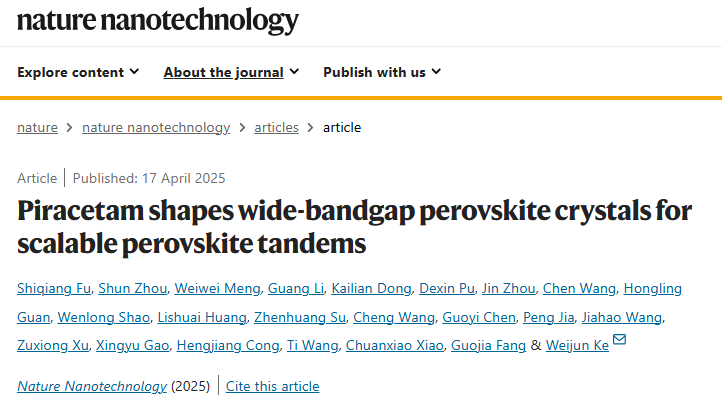
Perovskite materials have become a research hotspot for next-generation photovoltaic materials due to their excellent optoelectronic properties and low-cost manufacturing processes, widely applied in fields such as solar cells. Compared to traditional silicon materials, perovskite materials exhibit higher light absorption efficiency, lower manufacturing costs, and more flexible preparation methods.
However, the stability of perovskite materials and the reproducibility of large-scale production still face challenges, especially in the application of wide-bandgap perovskites, where these issues are more pronounced. These challenges include poor crystal quality, phase separation phenomena, and a significant decrease in efficiency as device size increases, particularly for large-area devices, which show a much larger efficiency gap compared to smaller devices. Therefore, improving the stability and uniformity of perovskite materials has become a key issue for achieving high-efficiency large-area all-perovskite tandem solar cells (TSCs).
In this regard, researchers from the School of Physics and Technology at Wuhan University, led by Professor Wei-Jun Ke, have made significant progress in the study of all-perovskite TSCs. The team designed and synthesized a novel crystal modifier—piracetam, which successfully enhanced the optoelectronic properties of the material by precisely regulating the crystallization process of wide-bandgap perovskites.
Piracetam plays a role during the nucleation stage of perovskites, promoting the formation of large-sized grains and enhancing the crystallinity and uniformity of the crystals. By adjusting the orientation of the grains, piracetam enables the perovskite film to exhibit a preferred (110) crystal plane orientation, effectively reducing defects and improving the optoelectronic characteristics of the film. During the annealing process, piracetam further eliminates PbI2 residues and forms one-dimensional (Pi) PbI3 (where Pi = piracetam) perovskite nanoneedles at the grain boundaries, a structure that improves crystal quality and enhances material stability.
Using this technology, the researchers successfully fabricated a single-junction perovskite solar cell with a bandgap of 1.77 eV, achieving an open-circuit voltage (Voc) of 1.36 V and a power conversion efficiency (PCE) of 20.35%. Furthermore, they achieved a PCE of 28.20% (certified value 27.30%) in large-area (1.02 cm²) all-perovskite TSCs, with minimal efficiency loss of only 0.51% compared to smaller devices.
Additionally, piracetam also demonstrates broad applicability, enhancing the PCE of 1.56 eV bandgap single-junction perovskites from 23.56% to 25.71%. This innovative method provides a new technological pathway for the large-scale production of efficient all-perovskite TSCs, holding significant application prospects.